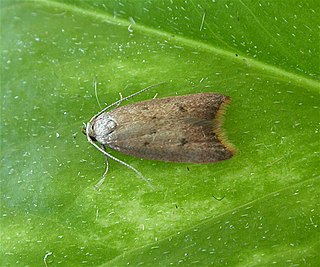
Tachystola acroxantha is a moth of the family Oecophoridae. It is native to Australia, but is an invasive species in New Zealand and Europe, probably imported with Australian plants.

The barea moth is a moth of the family Oecophoridae. It is found in Australia, more specifically Tasmania, New South Wales and Victoria and South Australia. It is also an adventive species in New Zealand.

The Depressariinae – sometimes spelled "Depressiinae" in error – are a subfamily of moths in the superfamily Gelechioidea. Like their relatives therein, their exact relationships are not yet very well resolved. It has been considered part of family Elachistidae sensu lato or included in an expanded Oecophoridae. In modern classifications they are treated as the distinct gelechioid family Depressariidae.
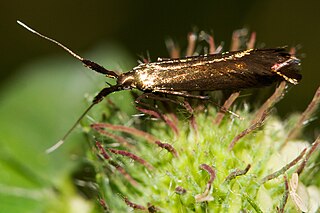
Coleophora deauratella is a moth of the family Coleophoridae. It is found in most of Europe, Asia Minor, Tasmania, North America and New Zealand.

Depressaria is a genus of moths in the superfamily Gelechioidea. It is the type genus of subfamily Depressariinae, which is often – particularly in older treatments – considered a distinct family Depressariidae or included in the Elachistidae, but actually seems to belong in the Oecophoridae.

The Oecophorinae are the nominate subfamily of moths in the concealer moth family (Oecophoridae). They are part of the insufficiently studied superfamily Gelechioidea, and like their relatives, the circumscription of this taxon is disputed.
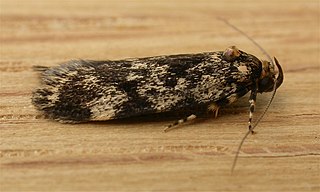
Barea is a genus of moths of the family Oecophoridae. The genus was erected by Francis Walker in 1864.

Trigonospila brevifacies is a species of true fly in the family Tachinidae native to eastern Australia. This species is also found in New Zealand. Like the vast majority of tachinid flies, T. brevifacies is a parasitoid of other insects, specifically late larval stages of a number of species of Lepidoptera. It is also known as the Australian Leaf-Roller Fly or Leafroller Fly.
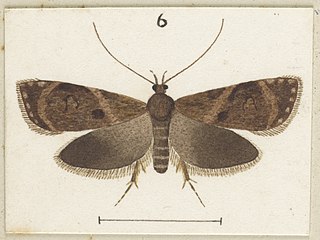
Izatha austera is a species of moth in the family Oecophoridae. It is endemic to New Zealand. The larvae of this species feed on dead wood by tunnelling into branches of its host species. The larvae matures from September and is on the wing in the months of December to January. The adult moth is variable in colouration but is seldom observed.

Izatha prasophyta is a moth of the family Oecophoridae. It is endemic to New Zealand, where it is known from the North Island, except Hawkes Bay or the Wairarapa. Larvae likely feed on rotting wood although larvae of this species have been reared on the fruiting body of the bracket fungus Bjerkandera adusta. Adults are on the wing from November to February.

The parsnip moth or parsnip webworm is a moth of the family Depressariidae. It is found in most of Europe, except Portugal and most of the Balkan Peninsula. This species has also been introduced into New Zealand.

Xyloryctidae is a family of moths contained within the superfamily Gelechioidea described by Edward Meyrick in 1890. Most genera are found in the Indo-Australian region. While many of these moths are tiny, some members of the family grow to a wingspan of up to 66 mm, making them giants among the micromoths.

Asaphodes abrogata is a moth in the family Geometridae. It is endemic to New Zealand and can be found from the central North Island as well as the South Island. This species is inhabits open country at altitudes of between 2000 and 4000 ft. Larvae have been reared on Plantago species including Plantago coronopus. It has been recommended that Plantago raoulii be planted to attracted this species. Adults are on the wing in February and March.

Tingena chrysogramma is a species of moth in the family Oecophoridae. It is endemic to New Zealand and is found in the North and South Islands. The adults of this species inhabits open scrubland and are on the wing in January and February. It has been collected via light traps and beating shrubs. During sunny days this species has been observed resting on leaves and rarely flies. It is regarded as a rare species and has a possible association with Prumnopitys ferruginea.

Tingena siderodeta is a species of moth in the family Oecophoridae. It is endemic to New Zealand and is found throughout the country. This species prefers to inhabit native forest and scrubland but has also been found to be common in cultivated landscapes. The larvae are litter feeders and have been observed in Kanuka and Manuka forest. The adult moths are on the wing from October to February and are day flying but have also been trapped at night.
Opsitycha squalidella is a moth of the family Oecophoridae. It was described by Edward Meyrick in 1884 and originally named Philobota squalidella. In 2018 the species Borkhausenia morella was synonymised with this species.
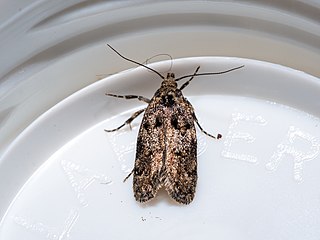
Trachypepla anastrella is a species of moth in the family Oecophoridae. It is endemic to New Zealand and has been observed in the North and South Islands. Larvae are leaf litter feeders from the host plant Olearia fragrantissima and adults are on the wing from December until March.

Trachypepla leucoplanetis is a moth of the family Oecophoridae first described by Edward Meyrick in 1883. It is endemic to New Zealand and has been collected in both the North and South Islands. It is the smallest moth species in the genus Trachypepla and the patterns on the forewings of adults are variable in appearance. It inhabits native forest and bush and the larvae feed on leaf litter. Adults are on the wing from October until February. T. leucoplanetis is regarded as being rarely observed and has been collected via the beating of foliage.

Trachypepla protochlora is a moth of the family Oecophoridae first described by Edward Meyrick in 1883. It is endemic to New Zealand and is found in both the North and South Islands. The preferred habitat of this species is native forest and adults are on the wing from October until February. Adults can be variable in their green shaded colour as well as in the intensity of markings on their forewings. The greenish ground colouration of this moth ensures they are well camouflaged when at rest on green mosses and lichens.

















